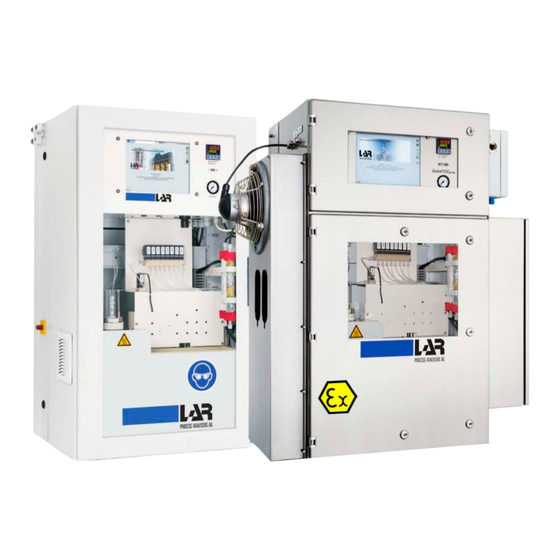
LAR Process Analysers QuickTOC purity Manuals
Manuals and User Guides for LAR Process Analysers QuickTOC purity. We have 1 LAR Process Analysers QuickTOC purity manual available for free PDF download: User Manual
LAR Process Analysers QuickTOC purity User Manual (196 pages)
Brand: LAR Process Analysers
|
Category: Analytical Instruments
|
Size: 27 MB
Table of Contents
-
Safety Notes17
-
Proceeding22
-
Advantages23
-
Proceeding23
-
Advantages24
-
Proceeding24
-
Advantages25
-
Product27
-
Front View29
-
Right Side32
-
Left Side33
-
Pump System33
-
Sample Pump35
-
Trackball40
-
Connections45
-
Power Supply48
-
Relays52
-
Carrier Gas56
-
Installation57
-
Carrier Gas63
-
Power Supply64
-
Start-Up69
-
Procedure69
-
Reagents87
-
General97
-
User Levels97
-
TC Delay100
-
TIC Delay100
-
Injection Time101
-
Averaging Values101
-
Cleaning Time102
-
Filling102
-
Calibration103
-
Injection Volume107
-
Relay Settings108
-
PC Settings109
-
Channel Display111
-
Signal Curve113
-
Status Screen113
-
Service Actions114
-
Maintenance116
-
Auto Check118
-
Setting Limits120
-
Purge Time122
-
Rinse122
-
Database122
-
Log125
-
Saving Data127
-
Good to Know128
-
Password128
-
Software Version128
-
Furnace on - off129
-
Date and Time129
-
Language129
-
Save129
-
User Level 3130
-
PC Settings130
-
CAN Selftest131
-
Hardware Info132
-
Calibrations135
-
Update Manager138
-
Names and Units139
-
Control State139
-
Tightness Test144
-
Overview146
-
Actions147
-
Loop System Tube159
-
Overview163
-
Mounting Rack164
-
Breakdowns172
-
Technical Data175
-
Specifications175
-
Flow Diagrams177
-
Operating Log184
-
Contact191
-
Contact to LAR191
-
Optimization191
Advertisement
